Bevins House
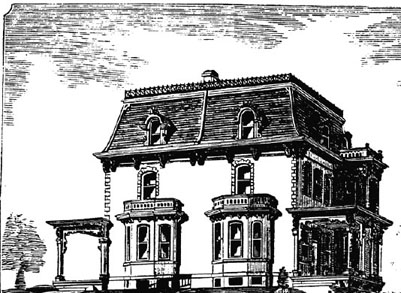
|
1216 Grampton Street
Newington, Southwark, London
The Bevins House is a boarding house in the Southwark's Newington neighborhood, run by the young married couple Albert and Gladys Bevins. Unlike many similar boarding houses which make no effort to keep the private living accommodations of their boarders strictly segregated along proper gender lines, the Bevins House is split directly down the middle, with one section for bachelors and another for women and married couples, as is appropriate.
Contents
Proprietors
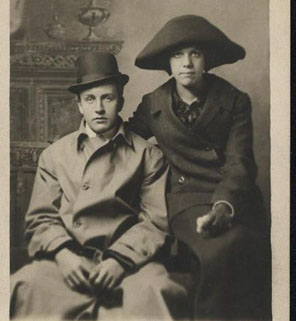
|
Albert Bevins
An engineer at the nearby Elephant and Castle train station, Albert inherited the grand old Bevins House from his aunt who elected to move to the country for her health. A proper young man with a bright future ahead of him, Albert married his schootime sweetheart recently, and the two of them now run the Bevins House, lending it a bit of their own youthful vigor and love for life, as well as a modern sensibility attractive to those looking for boarding in the Newington area.
Gladys Bevins
A sensible young woman with a fondness for supremely modern haberdashery, Gladys tends to the day-to-day operation of the Bevins House while her husband helps keep the trains running on Her Majesty's timetable. Hardworking and a good Christian woman, Gladys runs a tight ship. She is very scrupulous in ensuring the privacy of her residents, though any outward nonsense or impropriety will certainly earn a sharp retort from her, if not an insisted eviction. She is well aware of the reputation of many boarding houses in the Southwark, and will have none of that kind of goings-on in her home.
The House
The Bevins House is quite the modern house, for all it was built almost fifty years ago. It features a great number of very light and air windows, complete with fine draperies sewn by Gladys herself. The walls are decorated with beautiful wallpapering in light, comfortable pastoral hues, which set off the dark wood and jewel tones in the furnishings in a very fashionable and appealing taste.
Her one affectation is French porcelain, which she quite adores. Nearly every room in the house has an example or two of these sorts of crafts, though always of rigidly practical purpose, of course. The water basins and pitchers in every room are all French porcelain, as is her most treasured place settings (which only come out for holidays and the most special of occasions).
Mrs Bevins is a great believer in the loveliness of the natural British countryside - none of the "vulgar knick-knacks of the Far East so common these days" in her house, thank you. She is quite enamored of the Pastoral Movement, in fact, and looks forward to the day when her husband is successful enough to perhaps secure employment in a station far out in the country, away from the stink and illness of the big city.
The Tightly-Run Ship
The Bevins House is run in according to Mrs. Bevins' very strong ideas about how a proper household should be run. Though all her tenants pay, she insists that they are more akin to guests or visiting relations - she insists that so long as she treats them with the sort of grace a hostess in her own home should, they will likewise treat her with the courtesy of proper guests. She has heard far too many horror stories about other boarding houses, from the lady of the house treated like a common servant to thoroughly improper relations from not maintaining stringent social expectations between strangers. And she's having none of it. The house schedule runs as follows:
- Mornings: Windows are unshuttered in the house at 5 am, and meal preparations begin at 5:30.
- Breakfast: Served promptly at 6 am, and runs through 7:30 am, served in the appropriate dining rooms. Anyone expecting to be in the house for luncheon or tea is expected to inform Mrs. Bevins at this meal. Otherwise, the assumption is that they will be fending for themselves for such. Mr. Bevins generally leaves for work at just before 7 am.
- Cleaning: Once breakfast has been tended to and most of the residents have gone off to their days, Mrs. Bevins tends to the light cleaning of all areas of the house, including making the beds and clearing out supper dishes in the rooms and then deep cleans one area of the house depending on the day of the week. This regimen generally includes a strict dusting and a washing of walls and floors with a lemon-and-lavender wash. Wood is oiled in that room, and metals are polished. Rugs are dragged into the garden to be beaten once a week as well, usually on days when Mr. Bevins is around to aid in the heavy lifting. On Sundays, instead of cleaning, the Bevinses head to church at St. Savior & Ste. Marie Overie Cathedral, at the edge of Bermondsey.
- Luncheon: At 11 am, Mrs. Bevins completes her cleaning, retires upstairs for a brief refresher and then begins the simple luncheon, which is generally on the table by 11:30 (having done most of the onerous preparations alongside breakfast in the morning).
- Afternoon Endeavors: By 12:30, the remains of luncheon have been cleared away and cleaned, and it is time for Mrs. Bevins' afternoon to start. Most of the household shopping happens at this time of the day, generally at the nearby market, but Mrs. Bevins is also quite knowledgeable in the running of the omnibus routes, and so takes keen advantage of that to visit various shops. She is quite frugal, however, and a keen bargain-hunter. She always returns no later than 3 pm.
- Tea: Tea is served at 3:30 pm for those who have previously indicated they will be present. Unlike breakfast or luncheon, Mrs. Bevins does not serve during tea - she simply lays out the tea service and the tiered trays of sandwiches and sweet breads, and retires to her rooms for her own tea.
- Evening Endeavors: Evenings in the house tend to be quiet. Mrs. Bevins usually sticks to her own wing, tending to sewing and the myriad other little household projects that require little in the way of energy and can be done by gaslight, while waiting for her husband to get home, which generally happens at around 6 pm. She serves him his evening meal at that time, usually made up of a combination of the sorts of meals served throughout the day at the house.
- Supper: Just before bedtime proper, at about 7 pm Mrs. Bevins serves a simple supper, usually a sweet hot chocolate with a small slice of poundcake, in the rooms of residents. She also takes in any laundry to be tended at that time (as well as rent on Saturday evenings before Church, so that she can tithe appropriately).
- Lights Out: The lights are extinguished in the public parts of the house by 9 pm. Mrs. Bevins is very clear that residents may keep their lights burning in their rooms later than this, but the household is shut down at that point, and there should be quiet to allow decent folk to sleep properly.
First Floor
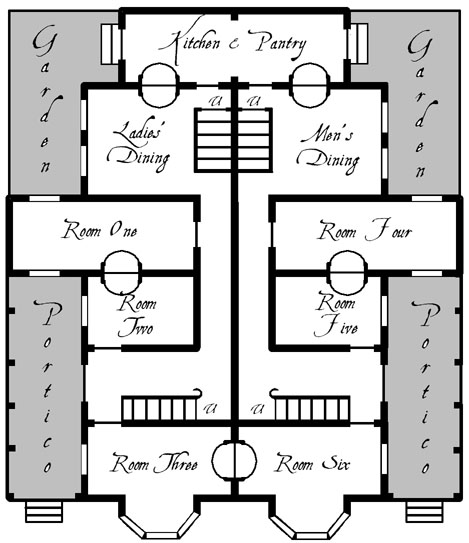
|
Ladies' Wing
The ladies' wing - intended for those few single women who pass Mrs. Bevins' muster, as well as the occasional newlyweds just moved to the city to make their lives together - is a place of understated floral elegance. Mrs. Bevins' love of the countryside shines through in the decor in this wing. The public areas of the house all have at least one simple vase of French porcelain with fresh flowers in it, and the smell of lavender pervades pleasingly.
- Portico: A simple hardwood porch, the ladies' side portico has small window gardens beneath each of the windows that look out onto it. The front door is a double-door inset with lovely stained glass depicting a rose coiling about a wreath, and the door bell chain connects to a distinctive-sounding light-toned bell in the foyer.
- Foyer: The foyer of the ladies' wing always smells quite nicely of flowers and the sweet church-wax used to keep the woods in fine condition here. To one side of the doorway is a table with a nice vase, always filled with fresh flowers, while a coat rack and umbrella stand sits on the other side of the doorway.
- Room One: The Pensworth Sisters' room. Their beds, with the soft, sombre-toned coverlets they prefer, are each set under the windows. A pair of reading chairs face the room's small hearth, and a wardrobe and vanity line the walls nearest the door. Seven shillings per week.
- Room Two: Nurse Marguerithe's room. Marguerithe sleeps in a curtained bed a bit too large for this room, and she usually keeps the curtains to her room window tightly drawn. A single chest that slides under her bed holds all her clothing, and a single chair sits beside the hearth, with a small bookshelf filled with a variety of books - both of a scholarly sort right down to penny dreadfuls - sits against the wall next to it. Five shillings per week.
- Room Three: The Lorigans' room. This is the only room that Mrs. Bevins doesn't come in to clean regularly, as there is almost never anything to do but collect the supper service - Mrs. Lorigan keeps their room spotless. Their marriage bed is covered in fine Irish woolen blankets in the middle of the room, its head near the hearth. A desk sits beneath the portico window, and a pair of small chairs at an informal table sit in the little windowed nook that overlooks the street. A wardrobe and vanity line the wall opposite that. Eight shillings per week.
- Ladies' Dining: The ladies' dining room is paneled in dark wood, and always has a fine bouquet of fresh flowers in the middle of the meal table.
Bachelor's Wing
Like the downstairs bachelors' wing, much of the color in this part of the house is a fine English hunter green, with complimentary brass metalworks here and there. The decorations themselves evoke hunting and riding scenes, though she has drawn the line at vulgar stuffed animal heads and the like, despite her husband's suggestions.
- Portico: A simple hardwood porch, the bachelor's portico windows are shuttered with attractive dark wood and brass finishings. The front door is a double-door inset with a stained glass window depicting a rearing stag beneath a curved hunting horn, and the door bell chain connects to a distinctive-sounding brassy-toned bell in the foyer.
- Foyer: The foyer of the bachelors' wing always smells quite nicely of citrus, leather oils, brass polish and the sweet church-wax used to keep the woods in fine condition here. To one side of the doorway is a table with a platter piled high with clove-studded oranges, while a coat rack and umbrella stand sits on the other side of the doorway.
- Room Four: X. Seven shillings per week.
- Room Five: X. Five shillings per week.
- Room Six: John Smith's room. Eight shillings per week.
- Gentlemen's Dining: The gentlemen's dining room is paneled in dark wood, and always has a fine bouquet of fresh flowers in front of the meal table.
Bevins' Wing
Mrs. Bevins clearly prefers the decorating techniques she applies to the ladies' wing, as their personal wings are likewise decorated. The kitchen and pantry, downstairs, are considered off-limits to residents, though residents may of course pass through them to get to the gardens.
- Kitchen & Pantry: X
- Gardens: X
Second Floor
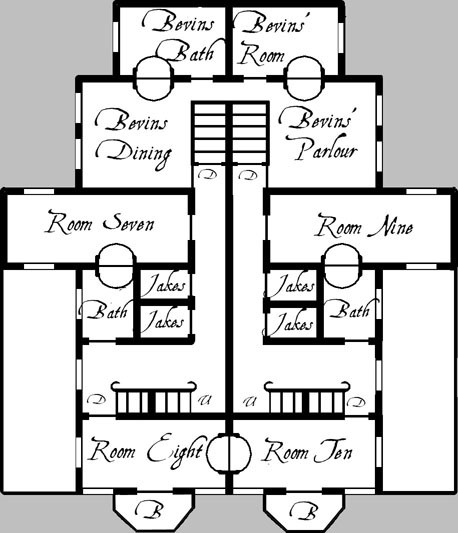
|
Ladies' Wing
Like the downstairs wing, the upper ladies' wing is a place of understated floral elegance. Mrs. Bevins' love of the countryside shines through in the decor in this wing. The public areas of the house all have at least one simple vase of French porcelain with fresh flowers in it, and the smell of lavender pervades pleasingly.
- Room Seven: Old Hattie's room. A room redolent with the smell of rich, sweet tobacco and the other herbs and oils she adds to make her personal blend, Old Hattie's room is a simple affair, furnished with old country-crafted woodwork, most of them heirlooms. Her bed is pushed up against the wall furthest from the door, and flanked by two windows. A small table sits to either side of her bed; one has a porcelain bowl and water pitcher, while the other has her pipe and a framed picture of her late husband Edbert. A big, cushioned chair sits beside the hearth, and a practically unused wardrobe and vanity are closest to the door. Seven shillings per week.
- Room Eight: The Widow Winthropes' room. Eight shillings per week.
- Bath: X
- Jakes: X
Bachelor's Wing
The bachelor's wing is - as its name suggests - intended for men only. It tends to say quite filled with residents, most of the time. The rooms in this wing are decorated with what Mrs. Bevins understands are the male sensibility, through the lens of her own pastoral interests, of course. As such, much of the color in this part of the house is a fine English hunter green, with complimentary brass metalworks here and there. The decorations themselves evoke hunting and riding scenes, though she has drawn the line at vulgar stuffed animal heads and the like, despite her husband's suggestions.
- Room Nine: Red's room. Seven shillings per week.
- Room Ten: X. Eight shillings per week.
- Bath: The gentleman's bath is paneled in cherry-colored wood
- Jakes: X
Bevins' Wing
The Bevins' personal living quarters are decorated with an eye for living, though Mrs. Bevins' preference for floral motifs certainly comes through up here. Most of it is muted, though, leaning towards lighter hues, in pale blues and whites, or much darker jewel tones, such as burgundy, over the brightness found elsewhere.
Attic
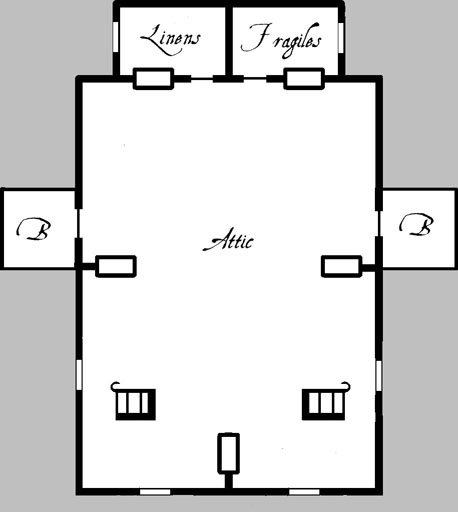
|
The attic, which can only be reached by way of the main stairs, is cavernous and quite large.
The main features in the attic are the large brickwork pillars which contain the chimney outlets to the roof of the house for all of the hearths in the household. In this larger main section, there are various crates, old pieces of furniture and assorted items, many of which are covered by drop cloths, most of which are shoved up against the walls, leaving the center of the attic uncluttered.
Four windows overlook the different directions from the attic space, and there are a pair of doors that lead out to balconies overlooking the gardens and porticos of the house as well. There are also a pair of interior doors that lead to smaller rooms.
Linens: The linens storage is stacked with an array of trunks and other storage boxes. Linens, chests of clothing and other cloth goods have been stored here, and the smell of moth balls and lavender sachets is quite pervasive here.
Fragiles: This storage room is lined with shelves and a large built-in china cabinet, on which have been stored a wide variety of glasses, dining sets and sets of china. A number of other fragile items, such as mirrors and picture frames, lean against the wall, each covered with its own individual drop cloth.
Other Residents
The Bevins House is home to the following individuals.
The Pensworth Sisters (Room One)
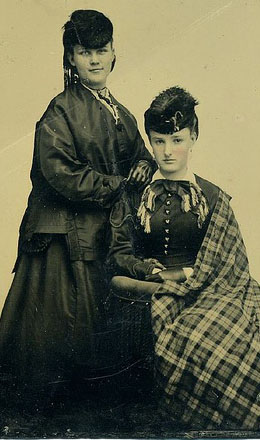
|
The Penworth Sisters, Lucinda and Sarah, are mild-mannered and polite, tending to avoid most of the other residents, and making appearances only for tea. Lucinda works in a dressmaker's shop in Newington, and often brings home projects she is working on. She also frequently brings Mrs. Bevins little things from the shop occasionally - a new shawl, a yard of pretty Scottish lace, or a little packet of nice new needles for her own sewing work.
Sarah works as a cleaning lady down at St. Saviour and Ste. Marie Overie. She is a bit more of a chatterbox than her sister is, and frequently pitches in to help Mrs. Bevins with more difficult household labors. The Bevins house always smells somewhat like a church, as Sarah brings home the tins of scented wax used at her work for the household waxing - she has reassured Mrs. Bevins that the rectory keeper has given all the girls permission to take the stuff home, as the director tends to purchase too much of it, and it dries out quickly.
Nurse Marguerithe (Room Two)
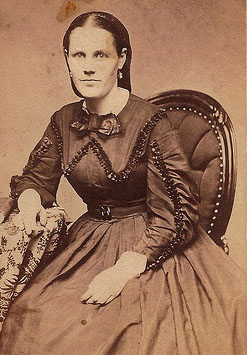
|
A nurse at Bedlam, Marguerithe Clooney is no-nonsense. She appreciates the quiet, and has very sharp ears; she does not hesitate to dress down noise-makers, and has had several confrontations with the sometimes-noisy Lorigans. She has also demonstrated a pointed dislike for the Pensworth Sisters, though she has never given a reason for this.
She very scrupulously treats Mrs. Bevins with perfect etiquette and propriety, which is just as well - Mrs. Bevins regards anyone who eschews attending church of any kind with a great deal of suspicion, and Marguerithe is one such.
Marguerithe's only real friend in the Bevins House is Old Hattie, whom Marguerithe checks in on occasionally. The two are old friends, and Mrs. Bevins suspects that the proper nurse has picked up Old Hattie's deplorable pipe-smoking vice.
The Lorigans (Room Three)
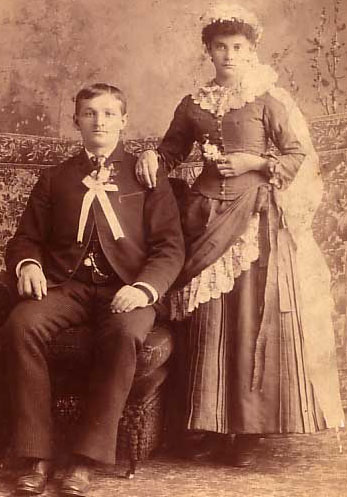
|
The Lorigans arrived from Ireland approximately six months ago, and are just settling in to London life. Thomas Lorigan, a round-faced black Irishman, is something of a lout, truth be told. He's been through two jobs already, and lost both of them thanks to his temper and quick willingness to resort to his fists. He just found work as a groundsman at Kennington Park, a job that seems to suit him far better than either of the two factory jobs he found previously, as he spends most of his time working out on the greens by himself, instead of packed in with other resentful workers. As long as he can temper his drinking, he'll probably keep this one - whatever else his flaws, Thomas clearly loves working with greenery. Indeed, the rapscallion has somewhat won Mrs. Bevins' heart for his secret gardening he does for her occasionally. He's clearly quite good at it, too, as her gardens are thriving like never before.
His wife, Siobhan, seems somewhat lost. She's clearly a country bride from the deeper parts of Ireland, and has quite a thick accent. Indeed, when Thomas and she argue - and they argue quite frequently - it's often peppered with the Gaelic phrases she seems most comfortable with. Siobhan has offered to help Mrs. Bevins around the house some, an offer which the proper lady of the house refused at first, until she saw how restless the young woman appeared. So now, Siobhan prepares one supper per week, and often helps Mrs. Bevins with larger household projects. The young woman has a beautiful singing voice, and she can often be heard singing something or another most of the day, when she isn't volunteering at St. George Cathedral, the Catholic church where she and Thomas go every Sunday.
Old Hattie (Room Seven)
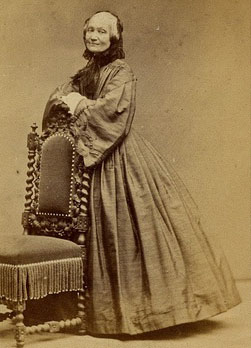
|
Old Hattie Black is widowed, and has been for nearly a decade now. Though she was the mother to two children, both of them died even before their father did, leaving Old Hattie alone in the world with no family. Still, she's a dedicated and strong-willed woman whose sometimes-coarse manners show her country upbringing.
Old Hattie makes her way in the world by selling cigarillos on the streets. Every night, she stays up quite late, seated in her chair with a bag of loose-leaf tobacco at her feet and the thin paper she buys from the Chinamen on the East End once a month cut into tiny squares, rolling up the cigarillos by hand. The tobacco she buys from the market once a week, and then mixes her own fragrant additions into it, leaving it a pleasant-smelling blend that she is quite well known for. Most of these nights, she and Marguerithe sit up in her room in front of the hearth, chatting away and sharing a pipe of the tobacco, a habit that Old Hattie practically grew up with, and one which Marguerithe has taken to with aplomb.
Hattie leaves the house most days after breakfast, her small oak box full of cigarillos to sell, returning before tea or after she's sold them all, whichever comes first. Some days, though, her joints pain her too much to leave the house, and so she stays to her room, emerging only for tea. She is distinctly uncomfortable with anyone making a fuss over her, so she tends to avoid answering her door when she is at home on such days, save for Marguerithe.